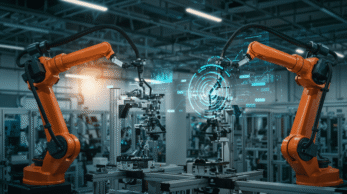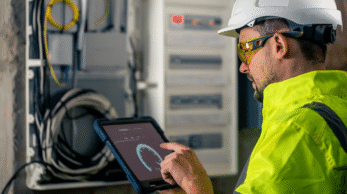Maintenance management today is facing major transformations, driven by the rise of predictive technologies and increasing demands for performance and sustainability. Between cost optimization, skill management, and the adoption of advanced solutions, managers must navigate a complex technical landscape. This article unveils concrete strategies and cutting-edge solutions to turn maintenance challenges into true performance drivers.
Challenge 1: integrating emerging technologies without complicating processes
Integrating technologies like IoT and AI is revolutionizing maintenance management, but it also poses challenges related to their complexity and cost. These tools allow for real-time data collection and analysis, providing a precise view of equipment conditions.
IoT and AI: assets for predictive maintenance: The Internet of Things (IoT) connects equipment via sensors capable of measuring critical parameters like vibration, temperature, or pressure. These data, once analyzed by AI algorithms, enable us to anticipate breakdowns before they occur. For example, a wear sensor on a mechanical bearing can detect a potential problem well before it results in failure.
However, these solutions require robust infrastructure for storing and processing massive volumes of data. Moreover, it’s crucial to separate useful data from superfluous information to facilitate decision-making and prevent decision-making overload. A clear strategy, starting with targeted pilot projects, is essential to maximize benefits.
Augmented and virtual reality: Augmented reality (AR) allows key information to be superimposed on equipment in real time using devices like connected glasses or tablets. Technicians can access schematics, instructions, or diagnostics without disrupting their work.
On the other hand, immersive virtual reality (VR) training enables technicians to simulate complex scenarios, ensuring they are prepared to handle critical situations. These tools help reduce errors and enhance team preparedness, but they require a significant initial investment in materials and content tailored to a company’s specific needs.
Challenge 2: bridging the skills shortage and valuing expertise
The aging workforce and the shortage of qualified talent are major issues for industrial maintenance. Strategies aimed at attracting, retaining, and developing skills are essential to maintain operational continuity.

Critical knowledge transfer: The loss of expertise due to retirement is a critical issue. Digitizing processes, creating expertise databases, or producing visual tutorials are effective solutions. Mentorship programs, pairing senior employees with young technicians, facilitate practical and personalized learning. This transfer of skills not only preserves technical know-how, it also contributes to strengthening cohesion and cultural transmission within teams.
Challenge 3: optimizing costs without sacrificing quality
In a context of increasing budgetary pressures, maintenance must be seen as a strategic investment, capable of generating substantial savings while improving overall performance.
Predictive maintenance: savings and performance
Unlike corrective or preventive maintenance, predictive maintenance relies on targeted intervention, dictated by the actual condition of the equipment. For example, monitoring the vibrations or temperatures of mechanical bearings can avoid costs associated with production interruptions or major failures.
Studies show that this approach can reduce unscheduled downtime by 30% to 50% and increase the lifespan of equipment by 20% to 40%. These results are achieved through real-time analysis of data collected by sensors.
Optimized spare parts management: Effective inventory management relies on balancing part availability with minimizing excess costs. Automated supply systems, based on AI, anticipate needs and avoid critical shortages. For example, the automation of supplies has allowed several industrial companies to significantly reduce their inventories while maintaining service rates above 95%, proving the effectiveness of these systems.
Challenge 4: balancing compliance, safety, and sustainability
Regulatory compliance, facility safety, and sustainable practices are interdependent challenges. Maintenance managers must navigate a strict framework while contributing to ecological performance.
Standards and audits: Adopting standards such as ISO 55000 (asset management) helps structure maintenance processes to improve equipment reliability. Additionally, regular checks and internal audits ensure ongoing compliance with regulatory requirements.
Sustainable Maintenance: Actions like repairing rather than replacing, using eco-friendly materials, and optimizing the energy efficiency of installations contribute to reducing the ecological footprint. These initiatives align the company with global sustainable development goals while generating substantial long-term savings.
Challenge 5: protecting data and preventing cyberthreats
In Industry 4.0, connected systems offer significant advantages but also expose companies to increased cybersecurity risks.
Securing systems: CMMS software, essential for centralizing and analyzing data, must be complemented by advanced security protocols. Network segmentation, data encryption, and continuous monitoring of activities help prevent cyberattacks.
Training and awareness: Human vulnerabilities represent one of the main security weaknesses. Training employees to recognize cyberthreats and adopt secure practices is vital to protect critical infrastructures. Regular awareness programs help maintain a high level of vigilance.
The increasing complexity of industrial environments requires maintenance managers to address multidimensional challenges. Thoughtful adoption of emerging technologies, valuing human skills, optimizing resources, and securing data are all levers to turn these challenges into opportunities. By embracing a proactive and integrated approach, maintenance becomes a central pillar of sustainable performance and industrial innovation.





